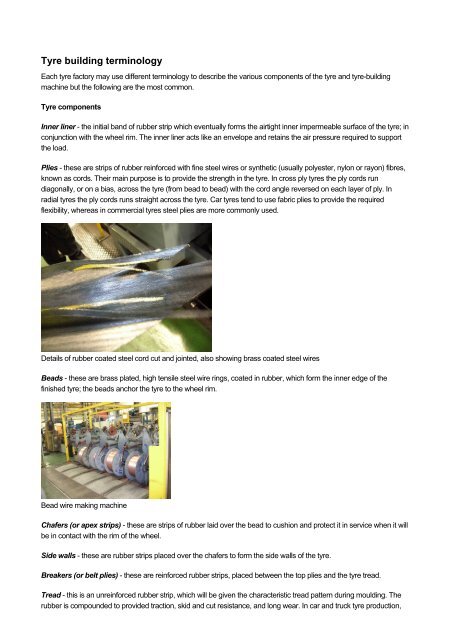Introduction to rubber processing and safety issues - HSE
Introduction to rubber processing and safety issues - HSE
Introduction to rubber processing and safety issues - HSE
Create successful ePaper yourself
Turn your PDF publications into a flip-book with our unique Google optimized e-Paper software.
Tyre building terminology<br />
Each tyre fac<strong>to</strong>ry may use different terminology <strong>to</strong> describe the various components of the tyre <strong>and</strong> tyre-building<br />
machine but the following are the most common.<br />
Tyre components<br />
Inner liner - the initial b<strong>and</strong> of <strong>rubber</strong> strip which eventually forms the airtight inner impermeable surface of the tyre; in<br />
conjunction with the wheel rim. The inner liner acts like an envelope <strong>and</strong> retains the air pressure required <strong>to</strong> support<br />
the load.<br />
Plies - these are strips of <strong>rubber</strong> reinforced with fine steel wires or synthetic (usually polyester, nylon or rayon) fibres,<br />
known as cords. Their main purpose is <strong>to</strong> provide the strength in the tyre. In cross ply tyres the ply cords run<br />
diagonally, or on a bias, across the tyre (from bead <strong>to</strong> bead) with the cord angle reversed on each layer of ply. In<br />
radial tyres the ply cords runs straight across the tyre. Car tyres tend <strong>to</strong> use fabric plies <strong>to</strong> provide the required<br />
flexibility, whereas in commercial tyres steel plies are more commonly used.<br />
Details of <strong>rubber</strong> coated steel cord cut <strong>and</strong> jointed, also showing brass coated steel wires<br />
Beads - these are brass plated, high tensile steel wire rings, coated in <strong>rubber</strong>, which form the inner edge of the<br />
finished tyre; the beads anchor the tyre <strong>to</strong> the wheel rim.<br />
Bead wire making machine<br />
Chafers (or apex strips) - these are strips of <strong>rubber</strong> laid over the bead <strong>to</strong> cushion <strong>and</strong> protect it in service when it will<br />
be in contact with the rim of the wheel.<br />
Side walls - these are <strong>rubber</strong> strips placed over the chafers <strong>to</strong> form the side walls of the tyre.<br />
Breakers (or belt plies) - these are reinforced <strong>rubber</strong> strips, placed between the <strong>to</strong>p plies <strong>and</strong> the tyre tread.<br />
Tread - this is an unreinforced <strong>rubber</strong> strip, which will be given the characteristic tread pattern during moulding. The<br />
<strong>rubber</strong> is compounded <strong>to</strong> provided traction, skid <strong>and</strong> cut resistance, <strong>and</strong> long wear. In car <strong>and</strong> truck tyre production,
















